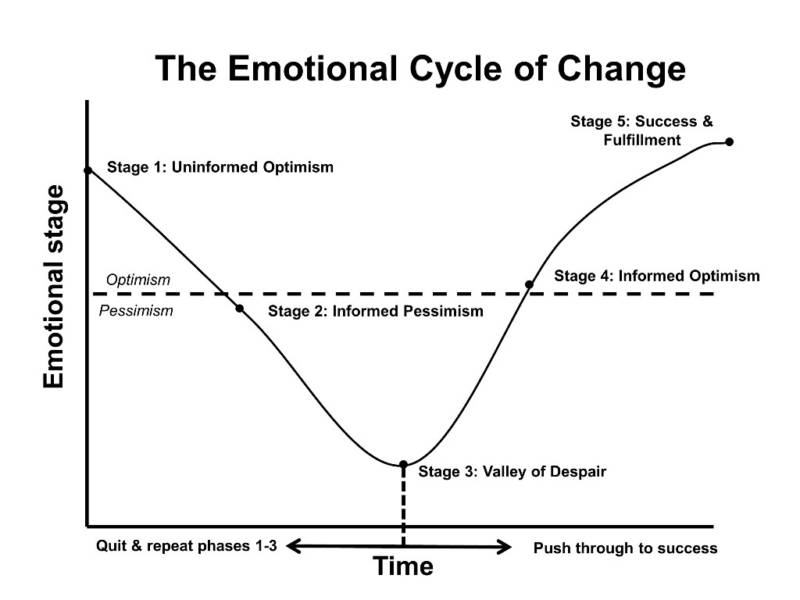To improve and grow, change is required. To change effectively, involves thought and emotion. Whether you are learning to ride a bike, lead in a new direction, propose a project to spend money, renovate the house, or get in better physical shape.
There are several change models out there but this one deals with the emotional aspects of change. It’s been adapted from Psychologists Don Kelley and Daryl Connor.*
If you understand the emotional cycle of change, it normalizes the range of emotion that occurs and keeps you and your organization from going off the rails. The cycle is present in all kinds of scenarios — a change in leadership, the introduction of new vision, the move from one type of board structure to another, and when learning new leadership competencies.

Five Stages People Move Through Emotionally When Changing Behavior
The five stages are uninformed optimism, informed pessimism, valley of despair, informed optimism, and success and fulfillment.
1. Uninformed optimism
This stage is the most exciting stage. You imagine the benefits but have not experienced any of the costs. Uninformed optimism sits above the line the land of positive emotion. You see all of the benefits of the change and none of the downside. You brainstorm and strategize for the future.
2. Informed pessimism
Uninformed optimism doesn’t usually last long. As you learn the reality of what it takes to change, positive emotions quickly sour with pessimism starting to set in. This stage is a shift to a negative emotional state. Here, the benefits don’t seem as real, important, or immediate, and the costs of the change is apparent. People question if the change is really worth the effort. You start looking for reasons to abandon the effort. But it gets worse.
3. Valley of despair
The lowest point of the emotional cycle is entrance into the valley of despair. This is when many people give up. The pain of change is felt and the benefits seem far away and unimportant. The quickest way to end the discomfort is to quit and go back to the way you did things before the change was introduced. The past doesn’t seem so bad at this stage.
If you quit here, you end up back at stage one and will have to start all over again. You will be able to persevere if you know why you’re making the change and have a compelling future vision of what you want to achieve.
4. Informed optimism
The fourth stage is informed optimism. The possibility of success increases and you are back in the positive emotional zone. The benefits of your actions are starting to bear fruit and the cost of change is feeling worth it. The key here is not to stop but keep going.
5. Success and fulfillment
Success and fulfillment is the final stage of the emotional cycle of change. Here, the benefits of your new behaviors are fully experienced and the cost of change is perceived now as worth it. The actions that were once difficult and uncomfortable are now routine.
Final Thought
Whether you are making meetings better, improving governance, implementing a challenging strategic plan, resolving unhealthy conflict, or changing something in your personal life, it will be an emotional ride. Know the ride. Embrace the ride. Use this knowledge to increase your chances of healthy change.
*Source: The 12 Week Year, by Brian P. Moran

